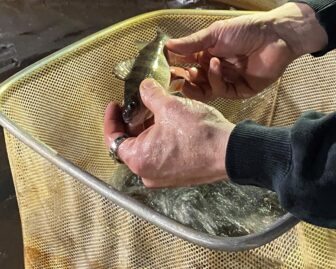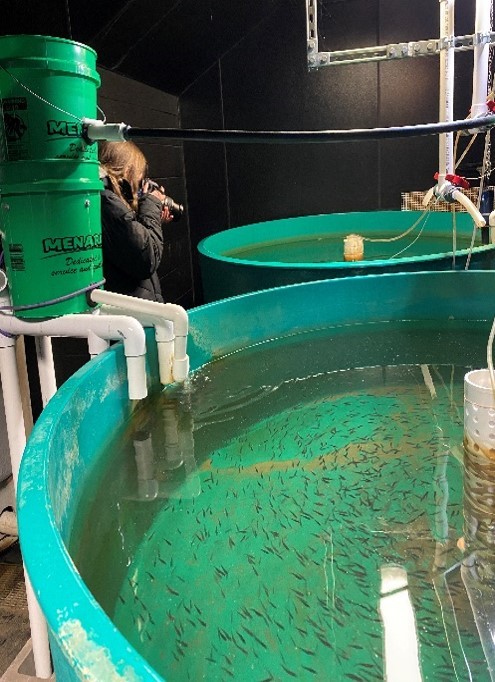
Great Lakes Aquaculture Collaborative team member holds a Yellow Perch pond. Image: Amy Schrank
By Audrey Richardson
An aquaculture group recently received $425,000 in federal support to strengthen the aquaculture community in the Great Lakes region.
The funding for the Great Lakes Aquaculture Collaborative comes from the National Oceanic and Atmospheric Administration National Sea Grant Office.
The collaborative is a part of the University of Minnesota and one of 34 university-based programs set up by the National Oceanic and Atmospheric Administration.
The goal for the grant is to build up the local economy of aquaculture producers, said Amy Schrank, lead scientist of the Sea Grant Aquaculture Collaborative.
The funding will be used to connect local aquaculture producers to larger organizations and educate legislators to support its future of the industry.
The grant is a two-year continuation of funding from a three-year project that began in 2019.
The project is led by Minnesota Sea Grant, but includes aquaculture specialists, fisheries biologists and educators from all of the Great Lakes states, Schrank said.
The first three years were heavily focused on research. The next two will be concentrated on outreach and collaboration, Schrank said.

Juvenile Yellow Perch in a hatching tank. Image: Amy Schrank
The collaborative will be informing legislators about the elements of aquaculture.
“A lot of people just don’t know about aquaculture in our regions, so it can get overlooked by legislators,” Schrank said
Providing science-based information to legislators, so they can make informed decisions on how aquaculture regulations can be implemented is the goal, Schrank said. Comparing aquaculture regulation across the U.S. states will be one method.
“We’re going to help legislators find reliable information about aquaculture and how they can get involved in their communities,” Schrank said.
Collaborating with legislators will be important as data suggests that wild fishery populations are decreasing, but the demand for fish is not, Schrank said.
“Right now about 54% of global seafood people eat is from capture fisheries and about 46% is grown by aquaculture,” Schrank said. “By 2030, it will be 47% from capture fisheries and 53% from aquaculture.”
Mark Rath, aquaculture manager at the National Sea Grant Office is also concerned about the fate of wild-caught seafood.
“There is ample data to show wild capture fisheries are not going to be able to produce anymore without damaging them,” Rath said.
The collaborative will also use funding to connect local producers with regional and national organizations to foster local education on the latest aquaculture innovations. Larger organizations include the North Central Regional Aquaculture Center, the United States Department of Agriculture, The U.S. Aquaculture Society and more.
“We really want to facilitate those connections, so local producers can benefit from information from those larger groups,” Schrank said.
The National Oceanic and Atmospheric Administration wants to expand an aquaculture community in the Great Lakes, Rath said.
Learning from the research gathered from the first three years of the project and developing an educated network of aquaculture enthusiasts will ensure the success of this grant, Schrank said.